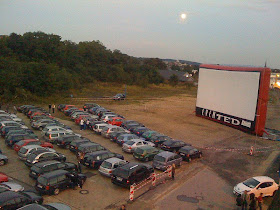 |
| Movie poster image courtesy of John Story. |
My parents never went to drive-in theaters; actually they hardly went to theaters at all. But I remember fondly going to the drive-in with neighbors and the families of friends. On a summer night in Southern California, not much could be finer. I remember getting really comfortable, often among the cushions spread in the bed of a truck, and eating food that we brought in ourselves - everything from real dinners to homemade goodies. And if the movie sucked, well, people-watching was a lot of fun. Especially the horny teenagers, of which there were lots.
 |
| Sappington, Missouri. Image courtesy of Stan Galczynski. |
By the time I was a teenager, going to drive-ins was a thing of the past, and there were very few left. Yes, the sound was always sucky and sometimes you had to move around to find a speaker that worked (before they began broadcasting the soundtrack over the radio), and if the lot wasn't slanted right you'd have to put up with people walking across your field of vision. The screens themselves were often in need of repair. I remember someone who lived in an apartment where you could see the screen if you hung out the window, and I thought that was pretty cool and where I would want to live someday (I didn't consider the fact that I'd have to hear the same movie night after night.)
 |
| Radio frequency sign at ticket booth. Image courtesy of Dave Page. |
The peak of popularity for drive-ins was 1958, when there were about 5,000 drive-ins operating in the United States. Today there are less than 500. There are many reasons for the decline: rising land values; daylight savings; video rentals; the advent of color television; and getting decent (first-run was almost impossible) films are just some of them. The rising cost of real estate due to urban sprawl may have been the single biggest deterrent. And showtimes were limited to after dark, although there were experiments with daytime showings under tents which failed. Weather, too, played a significant role - movies were often not viewable in inclement weather, making the drive-in experience a seasonal activity in some climates.
 |
| A drive-in in Dickson City, Pennsylvania. Image courtesy of Arnold Schuff. |
There is actually a patent held for the "invention" of the drive-in theater. U.S. Patent 1,909,537 was issued to Richard M. Hollingshead, Jr. on May 16, 1933. He opened the first one in Camden, New Jersey on June 6th of that year. It had a 40 x 50 foot screen with 400 slots. It only existed for three years, but by that time the idea caught on and drive-ins opened in other states. Hollingshead originally planned his "invention" at his home, nailing a screen to trees, and determining the space for vehicles in his driveway.
 |
| Hollingshead's drive-in. Image courtesy of www.wired.com. |
Because drive-ins were a popular dating venue they gained a reputation for being "dens of iniquity", and the media called them "passion pits." They also tended to show "B" movies. Soon they began to offer exploitation films, some made specifically for drive-ins. In the 70s, some drive-ins began showing porno films in an attempt to generate more income. This became problematic in crowded areas, and even at drive-ins in remote, rural areas. It was difficult to be sure the viewers were of age.
 |
| Newspaper ad for the Evansville, Indiana Westside Drive-in. Image courtesy of Bruce Lacoste. |
 |
| Ad for the Rustic Drive-in in North Smithfield, Rhode Island. Image courtesy of Quahog. |
Some drive-ins lent themselves to other activities, such as religious services on Sunday, swap meets, flea markets, and concerts. To augment the money they made from sales at snack bars or concession stands, some drive-ins had playground areas for children, petting zoos, miniature golf, and sit-down restaurants. Because cars often snuck people in without paying for them, drive-ins started to charge per car admission prices.
 |
| Image courtesy of Wikipedia. |
 |
| Concession at the Fort Myers, Florida drive-in. Image courtesy of Dave Page. |
In the past decade, there has been a revival of sorts that has been called the "guerrilla drive-in movement." Showings are advertised online, and films are projected on the walls of buildings, warehouses, or even giant bridge pillars. Most of these showings are cult, independent, or experimental films. Inflatable screens have been developed, and are often used for showing films outdoor, as well as for sporting and other social events.
 |
| An autokino event in Hückelhoven, Germany. Image courtesy of Wikipedia. |
 |
| An inflatable screen in Brussels, Belgium. Image courtesy of Wikipedia. |
Those of us of a certain age remember a classic comedy routine by Cheech & Chong - Pedro and Man at the Drive-In (on their album Los Cochinos.) There are a limited number of drive-ins left in the U.S., which is sad because great childhood memories are meant to be shared.
***************
Unless otherwise noted, images courtesy of www.drive-ins.com
*******************************
No comments:
Post a Comment
NOTE: COMMENTS WITH LINKS WILL NOT BE POSTED!